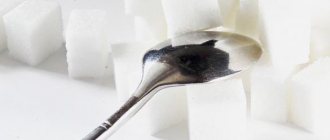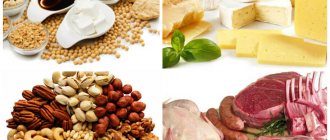Sucrose consists of glucose and fructose
Sucrose is the scientific name for table sugar.
Sugars are classified as monosaccharides or disaccharides.
Disaccharides consist of two linked monosaccharides and are broken down into them during digestion ().
Sucrose is a disaccharide consisting of one molecule of glucose and one molecule of fructose, or 50% glucose and 50% fructose.
It is a naturally occurring carbohydrate found in many fruits, vegetables and grains, but it is also added to many processed foods such as candy, ice cream, breakfast cereals, canned food, soda and other sweetened drinks.
Table sugar and sucrose found in processed foods are usually obtained from sugar beets or sugar cane.
Sucrose is less sweet compared to fructose, but sweeter than glucose ().
Glucose
Glucose is a simple sugar or monosaccharide. It is your body's preferred carbohydrate-based energy source ().
Monosaccharides are composed entirely of sugar and therefore cannot be broken down into simpler compounds.
These are the building blocks of carbohydrates.
In foods, glucose is most often combined with other simple sugars to form either polysaccharide starches or disaccharides such as sucrose and lactose ().
It is often added to processed foods in the form of dextrose, which is extracted from corn starch.
Glucose is less sweet than fructose and sucrose ().
Fructose
Fructose, or “fruit sugar,” is a monosaccharide such as glucose ().
It is naturally found in fruits, honey, agave and most root vegetables. Moreover, it is commonly added to processed foods in the form of high fructose corn syrup.
Fructose is obtained from sugar beets, sugar cane and corn. High fructose corn syrup is made from corn starch and contains more fructose than glucose compared to regular corn syrup ().
Of the three sugars, fructose has the sweetest taste, but has the least effect on blood sugar levels ().
Summary:
Sucrose consists of the simple sugars glucose and fructose. Sucrose, glucose and fructose occur naturally in many foods but are also added to processed foods.
Where is it kept?
The substance is present in the following products:
- honey;
- fruits;
- berries;
- vegetables;
- some cereal crops.
Honey is one of the leaders in the content of this carbohydrate. The product consists of 80% of it. The leader in the content of this carbohydrate is corn syrup - 100 g of the product contains up to 90 g of fructose. Refined sugar contains about 50 g of the element.
The leader among fruits and berries in terms of monosaccharide content is the date. 100 g of dates contain over 31 g of the substance.
Among the fruits and berries rich in the substance, the following stand out (per 100 g):
- figs - more than 23 g;
- blueberries - more than 9 g;
- grapes - about 7 g;
- apples - more than 6 g;
- persimmon - more than 5.5 g;
- pears - over 5 g.
The raisin grape variety is especially rich in carbohydrates. There is a significant presence of monosaccharide in red currants. A large amount of it is found in raisins and dried apricots. The first contains 28 g of carbohydrate, the second - 14 g.
A number of sweet vegetables also contain this element. The monosaccharide is present in small amounts in white cabbage; its lowest content is observed in broccoli.
Among cereal crops, the leader in fructose sugar content is corn.
What is this carbohydrate made from? The most common options are made from corn and sugar beets.
Video about the properties of fructose:
They are digested and absorbed differently
Your body digests and absorbs monosaccharides and disaccharides differently.
Because monosaccharides are already in their simplest form, they do not need to be broken down before your body can use them. They are absorbed by going directly into your bloodstream, primarily in the small intestine and to a lesser extent in the mouth ().
On the other hand, disaccharides such as sucrose must be broken down into simple sugars before they can be absorbed.
Once sugars are in their simplest form, they are metabolized in different ways.
Absorption and use of glucose
Glucose is absorbed directly through the lining of the small intestine, entering the bloodstream, which carries it to your cells (,).
It raises blood sugar levels faster than other sugars, which stimulates the release of insulin ().
Insulin is necessary for glucose to enter your cells ().
Inside cells, glucose is either used immediately for energy or converted to glycogen to be stored in the muscles or liver for future use (,).
Your body carefully monitors your blood sugar levels. When it gets too low, glycogen is broken down into glucose and released into your blood to be used as an energy source ().
If glucose is not available, your liver can get this type of sugar from other sources ().
Absorption and use of fructose
Like glucose, fructose is absorbed by passing directly into your bloodstream from the small intestine (,).
It raises blood sugar more slowly than glucose and does not appear to immediately affect insulin levels (, ).
However, although fructose does not immediately raise blood sugar levels, it may have longer-term negative effects.
Your liver must convert fructose into glucose before your body can use it for energy. If you eat more fructose than your liver can process, the excess is converted into cholesterol and triglycerides ().
This can have negative health effects such as obesity, fatty liver disease and high cholesterol.
Absorption and use of sucrose
Because sucrose is a disaccharide, it must be broken down before your body can use it.
Enzymes in your mouth partially break down the sucrose into glucose and fructose, and the acid in your stomach breaks it down further. However, most of the digestion of sugar occurs in the small intestine ().
The enzyme sucrase, which is produced by the mucous surface of the small intestine, separates sucrose into glucose and fructose. They are then absorbed into your bloodstream as described above ().
The presence of glucose increases the amount of fructose absorbed, which stimulates the release of insulin. This means that more fructose is used to create fat compared to when this type of sugar is consumed alone ().
Therefore, consuming fructose and glucose together may harm your health to a greater extent than when consumed separately. This may explain why added sugars, such as high fructose corn syrup, are linked to various health problems.
Summary:
Glucose and fructose are absorbed directly into your bloodstream, while sucrose must first be broken down. Glucose is used for energy or stored as glycogen. Fructose is converted to glucose or stored as fat.
Possible contraindications
If fructose becomes the main type of sugar in the diet, its benefits and harms become especially important.
Firstly, it is necessary to exclude a rare pathology in which the body lacks an enzyme that ensures the absorption of fructose.
Secondly, you need to pay attention to the energy balance, that is, weigh the daily calorie intake and energy expenditure. If you burn far fewer calories than you take in, your risk of developing obesity and related pathologies increases.
On the other hand, it turns into fat molecules (glycerol) faster. And if a person consumes too much fructose or doesn't move much during the day, fatty tissue quickly accumulates under the skin and inside liver cells.
And you need to consume fructose with caution if you are prone to edema, disruption of the heart, lungs and kidneys. Like other types of sugar, it binds water molecules and can retain fluid in tissues.
Fructose may be worse for health
Your body converts fructose into glucose in the liver to use it for energy. Excess fructose puts stress on your liver, which can lead to a number of metabolic problems ().
Several studies have demonstrated the harmful effects of high fructose intake. These include insulin resistance, type 2 diabetes, obesity, fatty liver disease, and metabolic syndrome (, ,).
In one 10-week study, people who drank fructose-sweetened drinks increased belly fat by 8.6%, compared to 4.8% for those who drank glucose-sweetened drinks ().
Another study found that while all added sugars may increase the risk of type 2 diabetes and obesity, fructose may be the most harmful ().
What's more, fructose has been shown to increase levels of the hunger hormone ghrelin and may make you feel hungry after eating (, ).
Because fructose is metabolized in your liver like alcohol, some evidence suggests it may be just as addictive. One study found that it activates the reward pathway in your brain, which can lead to increased sugar cravings (, ).
Summary:
Fructose has been linked to several negative health effects, including obesity, type 2 diabetes, insulin resistance, and fatty liver disease. Consuming fructose may also increase hunger and sugar cravings.
Maple syrup
One of the best sugar substitutes is maple syrup. It was made in Canada from sugar maple and comes in several varieties. Maple syrup is healthy and contains over 50 different antioxidants. Its taste is close to white sugar, and it is ideal as an additive to tea or coffee.
In terms of glucose content, maple syrup is close to sugar, and in terms of calorie content, it is much better suited for those who want to lose weight. Maple syrup has 2 times less calories, and if you are on a diet, it is better to add maple syrup to tea, coffee, muesli, porridge and other products instead of sugar. In addition, it is useful for men because it is a natural immunostimulant that enhances potency.
ul
You should limit added sugar
There is no need to avoid sugars, which are naturally found in whole foods such as fruits, vegetables and dairy products. These foods also contain nutrients, fiber, and water that counteract any of their negative effects.
The detrimental health effects associated with sugar consumption are due to the high levels of added sugar in the typical modern diet.
The World Health Organization recommends limiting added sugar intake to 5-10% of your daily caloric intake. In other words, if you eat 2,000 calories a day, you should reduce your sugar intake to less than 25-50 grams ().
For example, one 355 ml carbonated sweetened drink contains about 30 grams of added sugar, which may already exceed your daily limit ().
Moreover, sugars are not only added to foods that are obviously sweet, such as soda, ice cream and candy. Sugar is also added to foods you might not expect to find it in, such as condiments, sauces and frozen foods.
When purchasing processed foods, always read the ingredient list carefully to look for hidden sugars. Keep in mind that sugar can go by over 50 different names.
The most effective way to reduce your sugar intake is to eat mostly whole, unprocessed foods.
Summary:
Consumption of added sugars should be limited, but don't worry about those that occur naturally in foods. A diet high in whole foods and low in processed foods is the best way to avoid consuming added sugars.
Honey
As noted above, you can indeed replace sugar with honey, which is quite close in taste.
Natural honey is rightfully considered a healthy product - it contains vitamins B and C, protein, iron, potassium and many other trace elements. It is recommended to consume honey to prevent viral diseases, but eating honey instead of sugar every day is not the best idea. Unlike sugar, it is highly discouraged to add honey to hot drinks, since when heated to 50 degrees, it loses all its beneficial properties and turns into a carcinogen. That is why honey cannot completely replace sugar. In addition, for those who are watching their figure, honey is not suitable due to its calorie content. Thus, if you replace sugar with honey, you can get a slightly healthier product, which, at the same time, contains all the harm of sugar.
ul
Summarize
- Glucose and fructose are simple sugars or monosaccharides.
- Your body can absorb them more easily than the disaccharide sucrose, which must be broken down first.
- Fructose may have some of the worst health effects, but experts agree that you should limit your intake of added sugar, regardless of the type.
- However, there is no need to limit the sugars naturally present in fruits and vegetables.
- To ensure a healthy diet, eat whole foods as much as possible and limit your intake of added sugars to 25-50 grams or less per day.
Tags: Glucose, Sucrose, Fructose
- Related Posts
- Vitamin D: why women, men and children need it
- What is the correct dosage of vitamin C?
- Vitamin E overdose: symptoms, consequences, treatment
« Previous entry
Civilization is the enemy of humanity
The scourge of modern people is excess weight. It is considered an indispensable companion of civilization. It is a proven fact that in almost all developed countries of the world the number of people suffering from extra pounds (that is, obesity) and related ailments (cardiovascular diseases and diabetes) is steadily growing.
It is not surprising that many experts are now sounding the alarm and calling it an obesity epidemic. This “scourge” has affected the population of Western countries, including children. American nutritionists have long placed the blame on fats, particularly animal fats. And, consequently, in order to smooth out such an alarming situation, a total elimination of fats from almost all products began (including those where, by definition, they should be present). The fight against extra pounds has led to the appearance on supermarket shelves of low-fat cream, low-fat sour cream, low-fat cheeses and even low-fat butter. The appearance, consistency and color of such products closely replicate the original food products, but only reveal their taste.
The hopes of nutritionists were not justified: the health-improving effect never came. On the contrary, the number of overweight people has increased several times.











